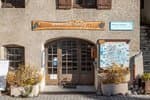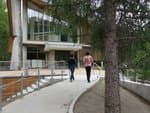The Col de la Pousterle (trail route no. 5)
“It was a beautiful autumn day and I knew it was somewhere about because I had just heard its very distinctive call. I peered into the larch branches and there it was. A tiny pygmy owl. Perched on a branch amid the red needles and the grey lichens, it was looking at me.” Marie-Geneviève Nicolas, park ranger at the Parc National des Écrins.
Description
Go through the campsite, carry on along the track and after 200 metres take a path which runs uphill to the left.
- Fork left. Cross the road leading to Puy Saint-Vincent and carry straight on along a track leading uphill to the houses in Eyssarvia. Carry on along the track.
- Above Eyssarvia, take the track on the left leading to La Bâtie des Vigneaux and after 400 metres, take the path on the right for the Col de la Pousterle. The path leads to the bottom of a limestone cliff and, at this point, runs across a sharp bend in a track. Carry on along this path until you reach the track leading uphill to the pass and cuts through some winding bends. You come to the pass.
- Take the track leading directly left. This rises uphill before taking you along a long stretch across the hillside on the northern slope. On the eastern slope, it descends more directly.
- Take care not to miss the path when crossing the track over a large flat area; to find the path. you first start to cross a small meadow. Lower down, it joins the track again, and you follow this for some distance before taking a path leading back to Les Vigneaux.
- Departure : Camping le Courounba, Les Vigneaux
- Arrival : Camping le Courounba, Les Vigneaux
- Towns crossed : Les Vigneaux, Vallouise-Pelvoux, and Puy-Saint-Vincent
Altimetric profile
Recommandations
Before setting off, it is very important to check the opening periods for this route on the website: https://stationdetrail.com/fr/stations/le-pays-des-ecrins/parcours
Share your photographs on social networks with #stationdetrailecrins
Check weather conditions before setting off.
Rescue services contact details: Secours Montagne (Mountain Rescue): +33 (0)4 92 22 22 22 or 112
Show consideration for the work of farmers, livestock keepers and owners
Close all gates behind you
Take your litter home
Do not take shortcuts across pastureland
The trail routes are also suitable for walking
Information desks
Place de l'Eglise, 05340 Vallouise
Vallouise Park house
, 05290 Vallouise
Information, documentation, models, exhibitions, screenings, product sales and works of the Park. Guided tours for school, reservation required. The new Park House opened in Vallouise since June 1, and offers visitors an interactive permanent exhibition inviting to explore the area and its heritage. A temporary exhibition space will allow a renewed offer. Finally, the device is completed by an audiovisual room to organize screenings and conferences Free admission. All animations of the Park are free unless otherwise stated.
Transport
Public transport >> www.pacamobilite.fr
Consider car-sharing >> www.blablacar.fr
For more information, ask at the Tourist Information Office nearest to the trail starting point.
Access and parking
10 km from L'Argentière-La Bessée, take the D994E.
Parking :
Sensitive areas
Short-toed snake eagle
- Impacted practices:
- Aerial,
- Sensitivity periods:
- MarAprMayJunJulAugSep
- Contact:
- Parc National des Écrins
Julien Charron
julien.charron@ecrins-parcnational.fr
Peregrine falcon
- Impacted practices:
- Aerial, Vertical
- Sensitivity periods:
- FebMarAprMayJun
- Contact:
- Parc National des Écrins
Julien Charron
julien.charron@ecrins-parcnational.fr
10 points of interest
 Geology and geography
Geology and geographyThe "ubac"
The track rises gently up the right-hand bank of the Gyronde, on the "ubac" side. The "ubac" is the slope that is exposed to the north, so it is in shadow in winter when the sun is low in the sky. Fauna
FaunaCliff-dwelling birds
The cliff is home to a variety of birdlife. The raven, not to be confused with the crow, frequently nests here. He makes an uncomfortable housemate with the peregrine falcon, a bird in sharp decline and still a vulnerable species. It, too, favours this cliff, which offers plenty of potential nesting holes. The wallcreeper, also known as the butterfly bird, also finds this a good nesting spot. Some climbing routes are closed during this bird's breeding season.
 Pass
PassThe Col de la Pousterle
A pousterle (in the local high-alpine Occitan language) is a small gate, a postern. It comes from the Latin posterula which means back door. This place name is sometimes given to a pass, which could be described as a gateway between two valleys! The glaciers carved out this gateway through which an arm stretched between the glacier occupying the Fournel valley and the glacier flowing down the Vallouise valley.
 Flora
FloraThe larch
The symbol of the Southern Alps, this softwood tree loses its leaves in winter, and is swathed with gold and lights up the mountains in autumn. The larch forests are maintained by the grazing of flocks. Without them, other trees like the fir or other pine trees could grow, creating a different kind of forest. A pioneer species, the larch establishes freely in light conditions. Its solid rot-proof wood has always been used in the construction of houses.
 Fauna
FaunaForest-dwelling bats
Bats don't just live in caves! In summer, some forest-dwelling species shelter in old hollow trees or woodpecker holes during the day. Sometimes, the females also form little colonies here, where their young will be born (one bat pup per female). In this forest, which is still young with very few old trees, artificial roosts have been installed to help the bats and to facilitate their study. Fauna
FaunaThe pygmy owl
The call of this small, nocturnal bird of prey can be heard in the spring, and also in the autumn when it can utter some peculiar sounds. Active during daytime hours and at dusk, the pygmy owl is a predator of passerine birds and small forest rodents. But when they spot it, passerines will come together in large numbers to mob it, so as to prevent any attempted surprise attack. It is restricted to mountain forests where it seeks out trees with woodpecker cavities where it builds its nest.
 Flora
FloraThe rosebay willowherb
The forest tracks are edged with great swathes of a tall plant which has purple flowers arranged in loose spikes. The rosebay willowherb is a pioneer plant and favours road embankments and disturbed ground. In late summer, its very numerous seeds, each with a little plume, float away en masse glowing in the advancing twilight…
 Flora
FloraThe alpine laburnum
A cousin of the common laburnum, this large shrub flowers in June-early July, producing beautiful drooping clusters of yellow flowers. Not very common and only found in the Alps and the Jura, it favours quite dry, airy woods. A beautiful surprise, and heavenly scent!
 Flora
FloraThe sessile-leaved cytisus
This small shrub which grows to 1 to 2 metres in light woods is characterised by three-lobed leaves on the flowering shoots which are sessile, that is to say without a stalk. It is easy to confuse with the scorpion senna, which has the same leaves but they are divided into 7 or 9 lobes. Both produce very beautiful yellow flowers in May to June.
 Fauna
FaunaThe roe deer
The forest is home to roe deer, which can often be seen. This ungulate (hoofed mammal) is rather unusual because the rut does not take place in autumn, for births in May and June as is the case with other mountain-dwelling ungulates, but in summer. After fertilisation, however, egg development is suspended for 6 months (this is called embryonic diapause). Gestation then resumes so that the fawn (or twin fawns) can be born in spring, a period more favourable for its survival.
Source

Report a problem or an error
If you have found an error on this page or if you have noticed any problems during your hike, please report them to us here:


